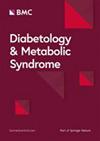预后营养指数对心肌梗死糖尿病患者的影响
IF 3.4
3区 医学
Q2 ENDOCRINOLOGY & METABOLISM
引用次数: 0
摘要
预后营养指数(PNI)是一种简单而全面的营养和免疫健康预测指标,与癌症和心血管疾病有关。预后营养指数对糖尿病患者心肌梗塞(MI)的影响尚不清楚。因此,我们旨在研究 PNI 与这一特殊人群的预测结果之间的相关性,为治疗决策提供依据。这项前瞻性观察研究纳入了2017年5月至2020年5月期间在福建医科大学附属协和医院接受冠状动脉造影介入治疗的417例糖尿病心肌梗死患者。我们通过门诊访问或电话访谈收集了这些患者术后6、12、18和24个月的随访和预后数据。研究的重点是术后两年内的主要心血管不良事件(MACE)。根据 PNI 中位数将患者分为两组:高 PNI 组(H-PNI)和低 PNI 组(L-PNI)。数据使用 IBM SPSS 25.0 进行分析。利用 Kalpan-Meier 生存曲线和 Cox 比例危险回归分析来研究糖尿病心肌梗死患者术前 PNI 与预后之间的关系。研究对 417 名参与者进行了为期两年的观察。在这些患者中,159 人(38.1%)发生了 MACE。根据 Kaplan-Meier 曲线,L-PNI 组患者的 MACE 发生率高于 H-PNI 组(对数秩 P < 0.001),并且更容易发生各类 MACE。调整混杂变量后,L-PNI 组发生不稳定型心绞痛的校正危险比为 2.55(95% CI 1.57-4.14,p < 0.001)。低 PNI 水平与糖尿病心肌梗死患者接受冠状动脉造影术干预后的 MACE 相关。这凸显了 PNI 的预后价值,并扩大了其在更大人群中的潜在应用。试验注册:不适用。本文章由计算机程序翻译,如有差异,请以英文原文为准。
The effect of prognostic nutritional index on diabetic patients with myocardial infarction
The prognostic nutritional index (PNI), a simple and comprehensive predictor of nutritional and immunological health, is connected to cancer and cardiovascular disease. The effects of PNI on myocardial infarction (MI) in individuals with diabetes remain unclear. Thus, we aim to investigate the correlation of PNI with predictive outcomes in this specific population group to inform therapeutic decision-making. This prospective observational study included 417 diabetic patients with MI who underwent coronary angiography intervention at Fujian Medical University Union Hospital from May 2017 to May 2020. We collected follow-up and prognostic data from these patients at 6, 12, 18, and 24 months post-procedure via outpatient visits or phone interviews. The main focus of the study was on major adverse cardiovascular events (MACE) in the two years after surgery. Based on the median PNI, patients were categorized into two groups: high PNI (H-PNI) and low PNI (L-PNI). Data were analyzed using IBM SPSS 25.0. Kalpan-Meier survival curves and Cox proportional hazards regression analysis were utilized to examine the associations between preoperative PNI and the prognosis of diabetic patients with MI. In the study, 417 participants were observed for two years. Of these patients, 159 (38.1%) had MACE. According to the Kaplan–Meier curves, patients in the L-PNI group had more MACE than those in the H-PNI group (log-rank p < 0.001) and had a heightened susceptibility to all categories of MACE. After adjusting for confounding variables, the corrected hazard ratio for developing unstable angina in the L-PNI group was 2.55 (95% CI 1.57–4.14, p < 0.001). Low PNI levels are associated with MACE after coronary angiography intervention in diabetic patients with myocardial infarction. This highlights the prognostic value of PNI and broadens its potential use in larger populations. Trial registration: Not applicable.
求助全文
通过发布文献求助,成功后即可免费获取论文全文。
去求助
来源期刊

Diabetology & Metabolic Syndrome
ENDOCRINOLOGY & METABOLISM-
CiteScore
6.20
自引率
0.00%
发文量
170
审稿时长
7.5 months
期刊介绍:
Diabetology & Metabolic Syndrome publishes articles on all aspects of the pathophysiology of diabetes and metabolic syndrome.
By publishing original material exploring any area of laboratory, animal or clinical research into diabetes and metabolic syndrome, the journal offers a high-visibility forum for new insights and discussions into the issues of importance to the relevant community.
 求助内容:
求助内容: 应助结果提醒方式:
应助结果提醒方式:


